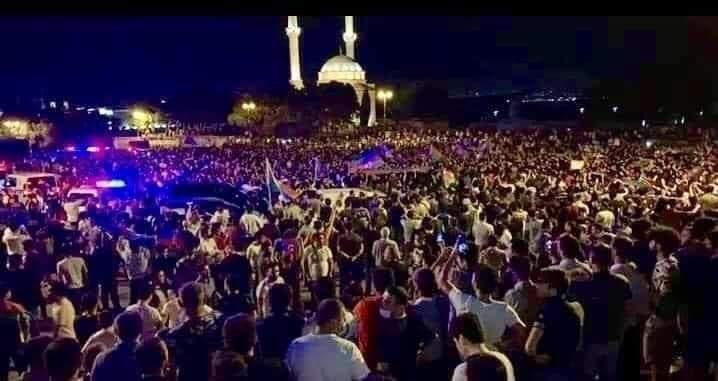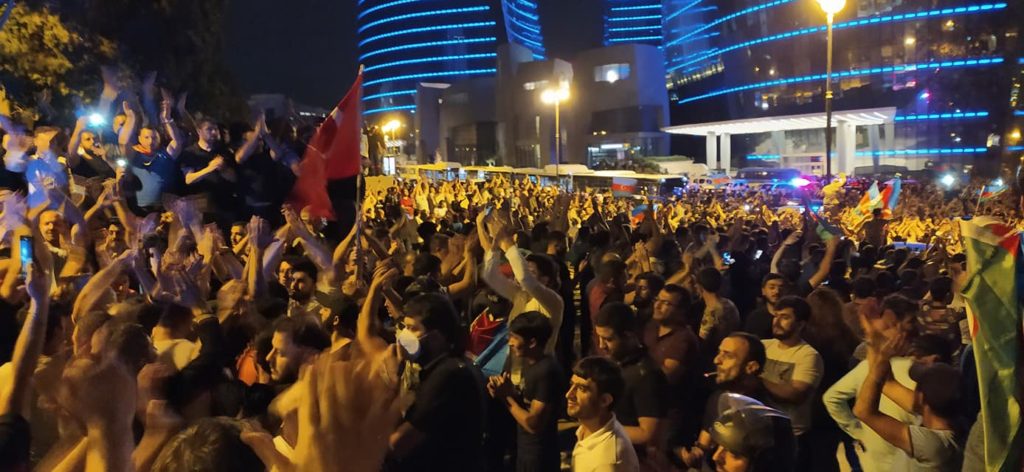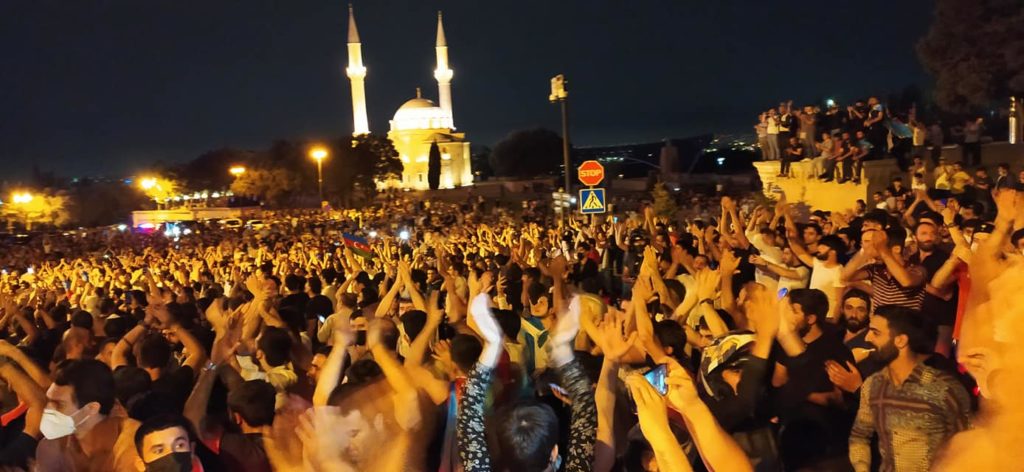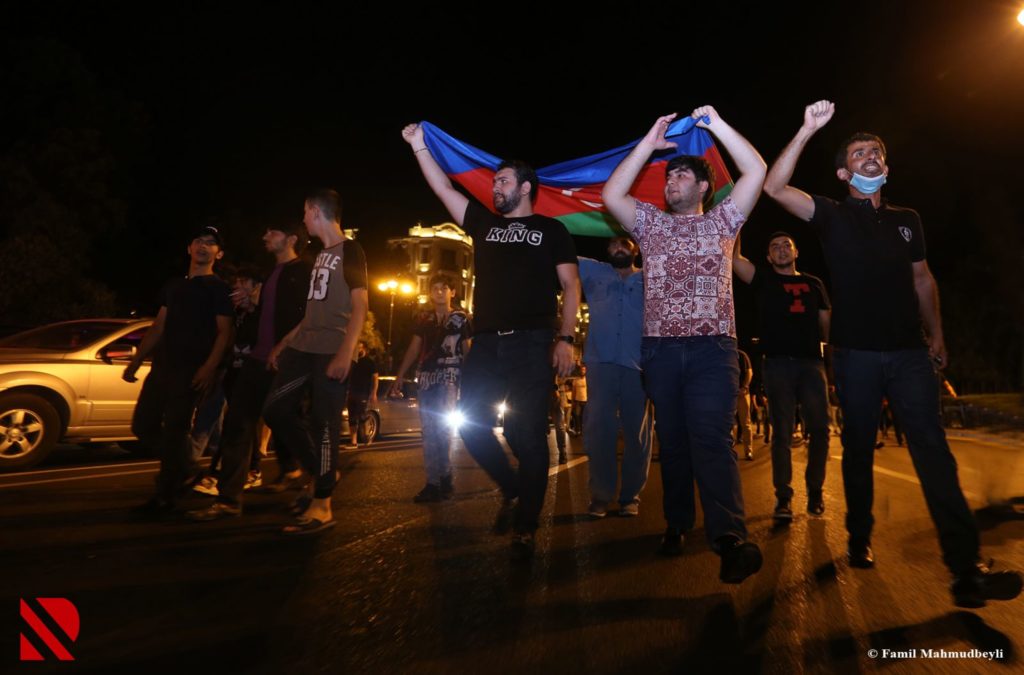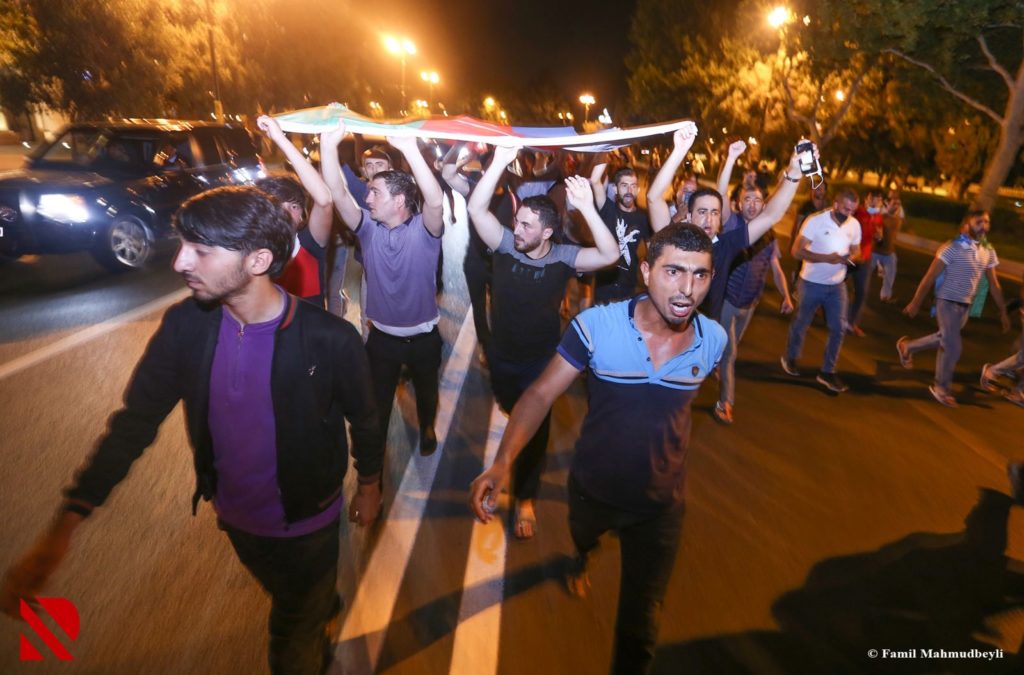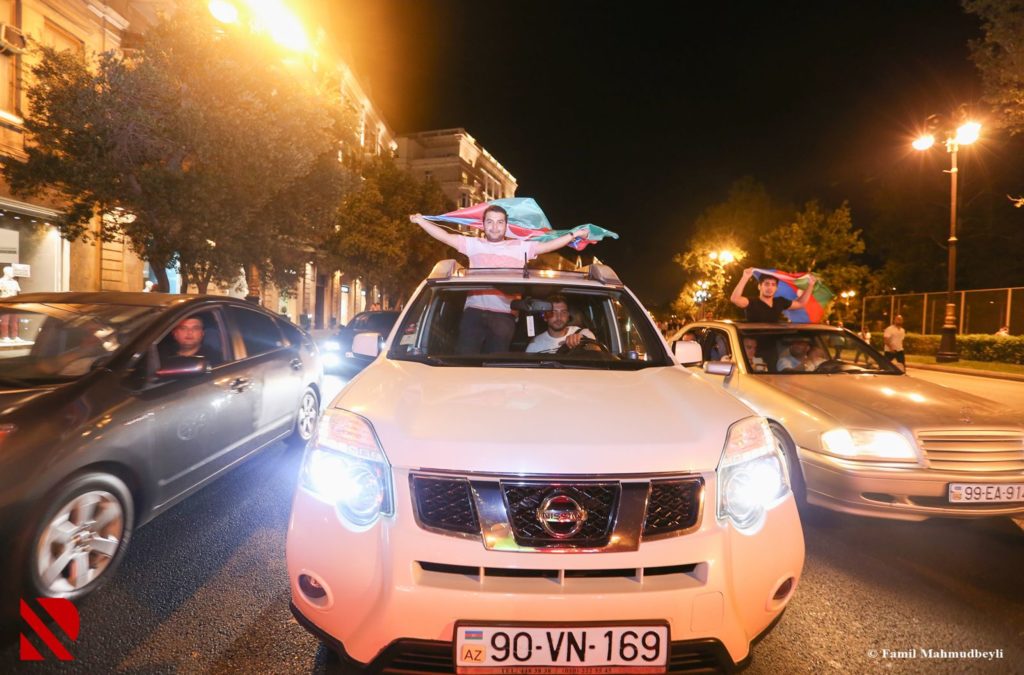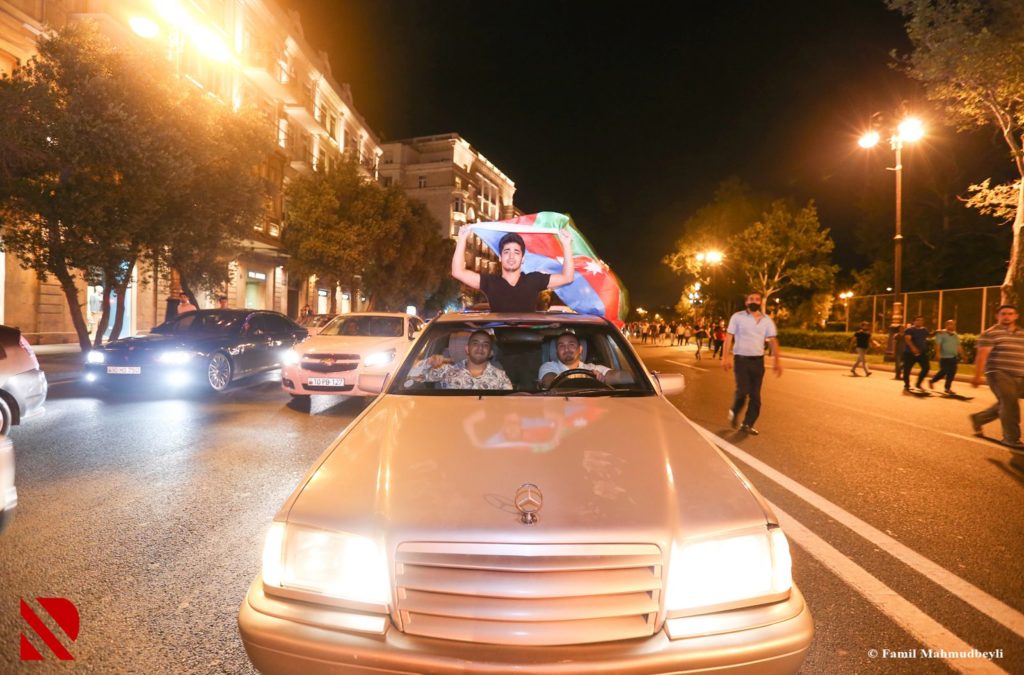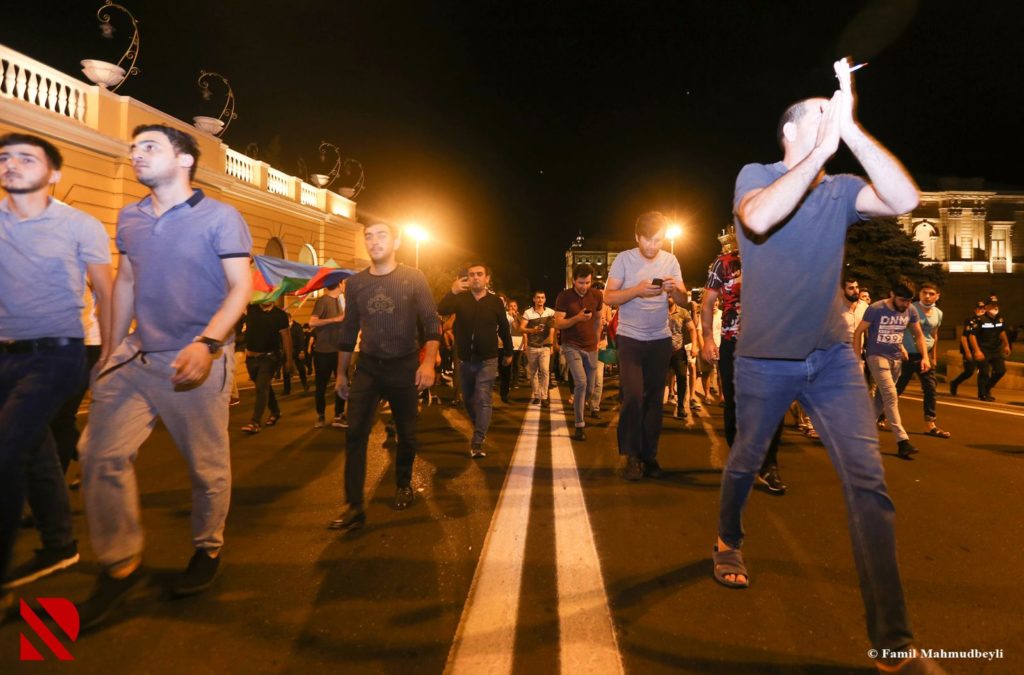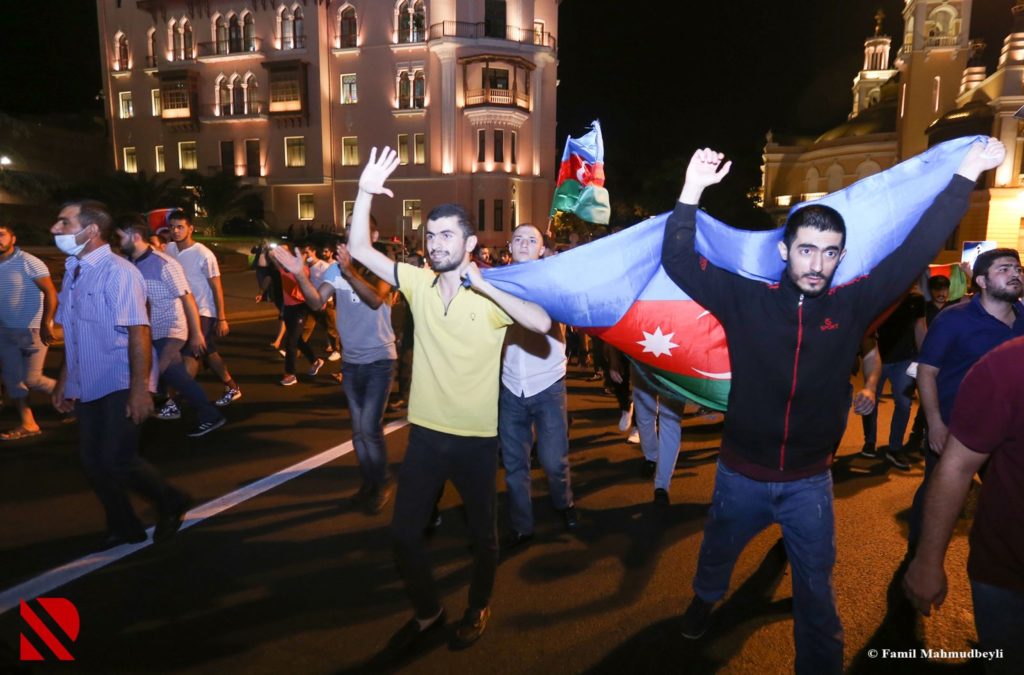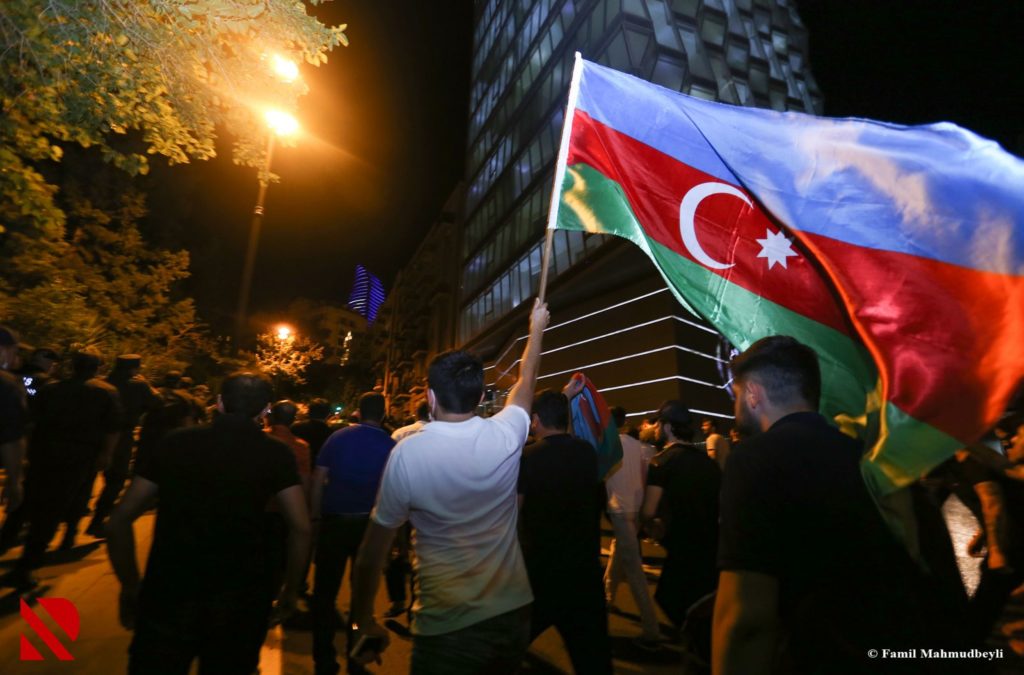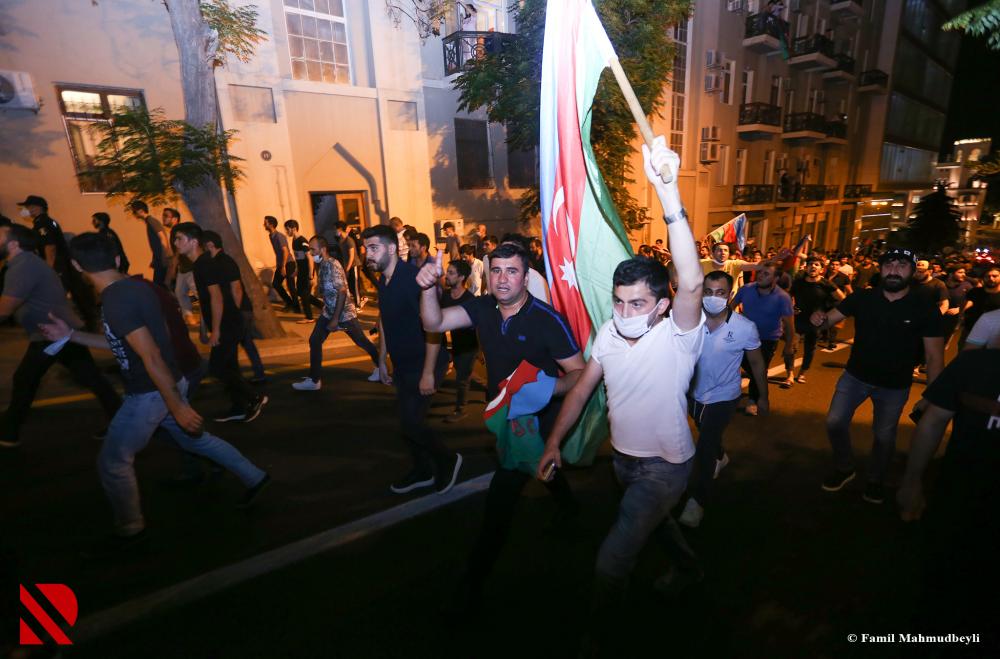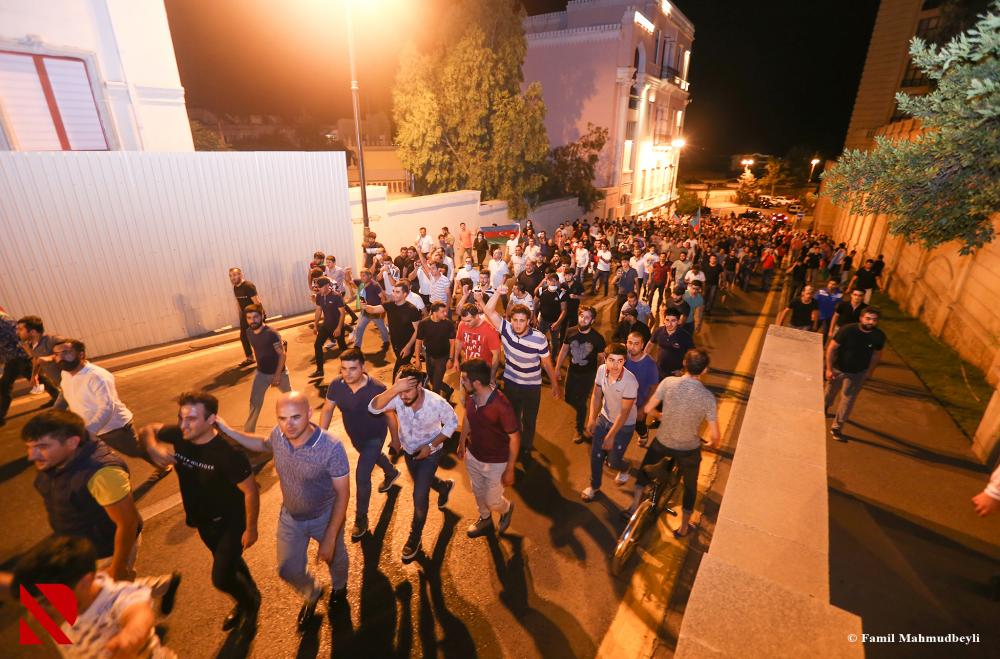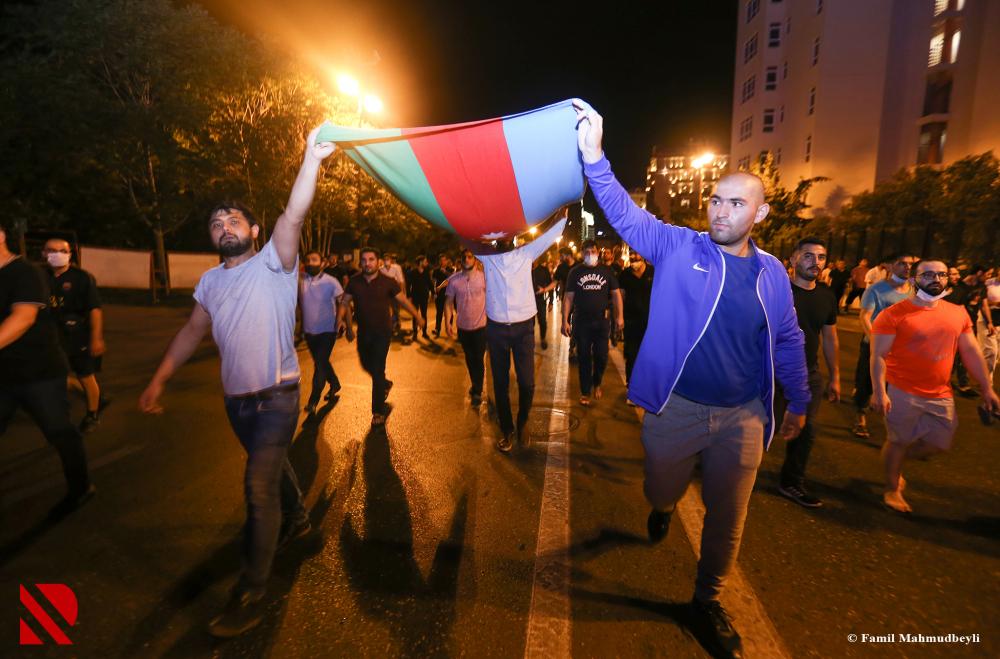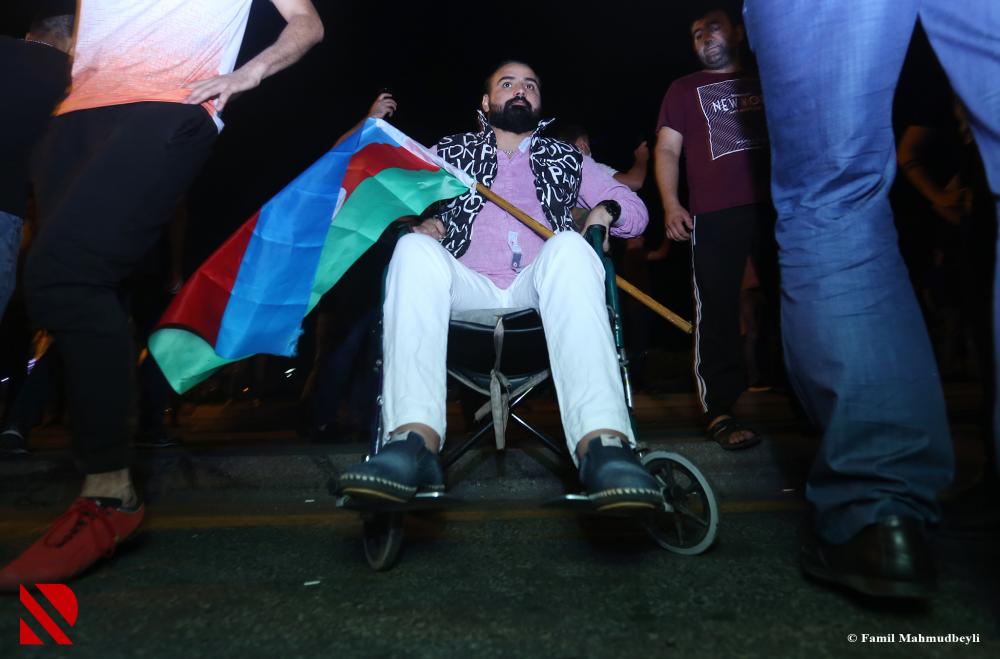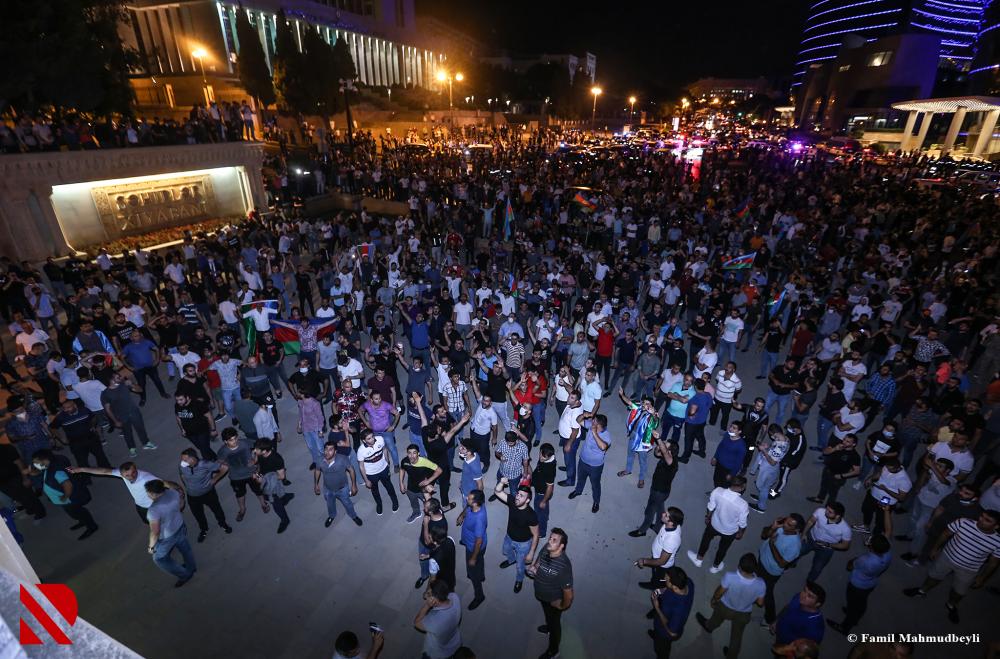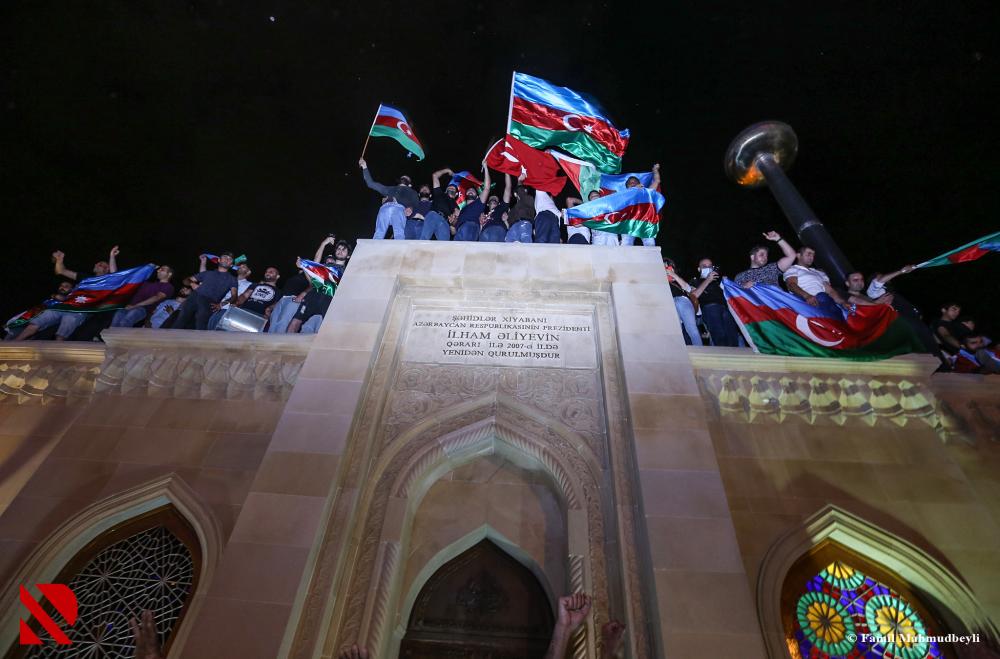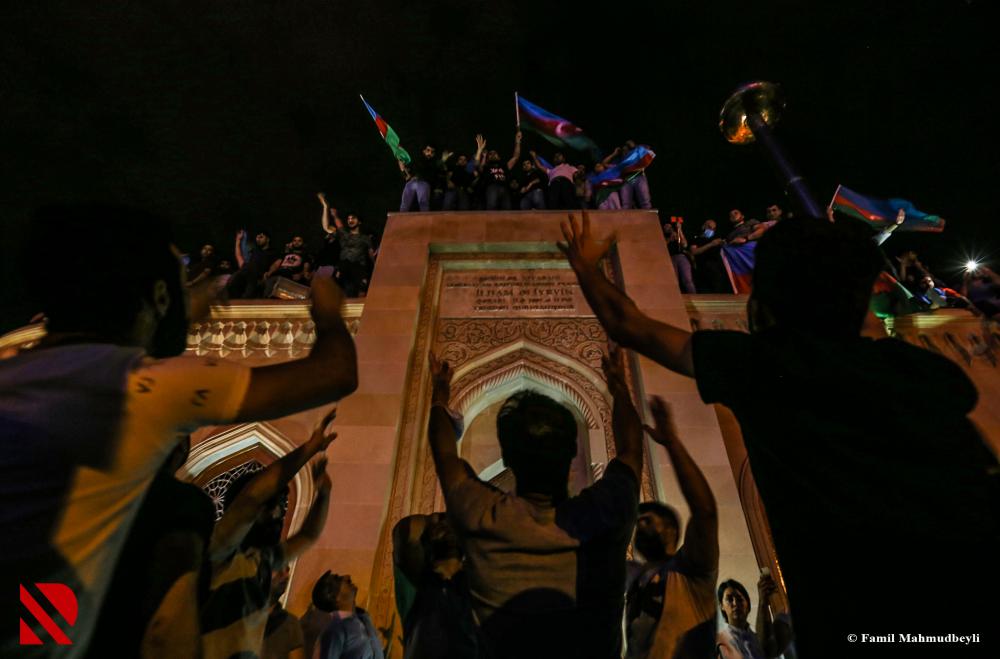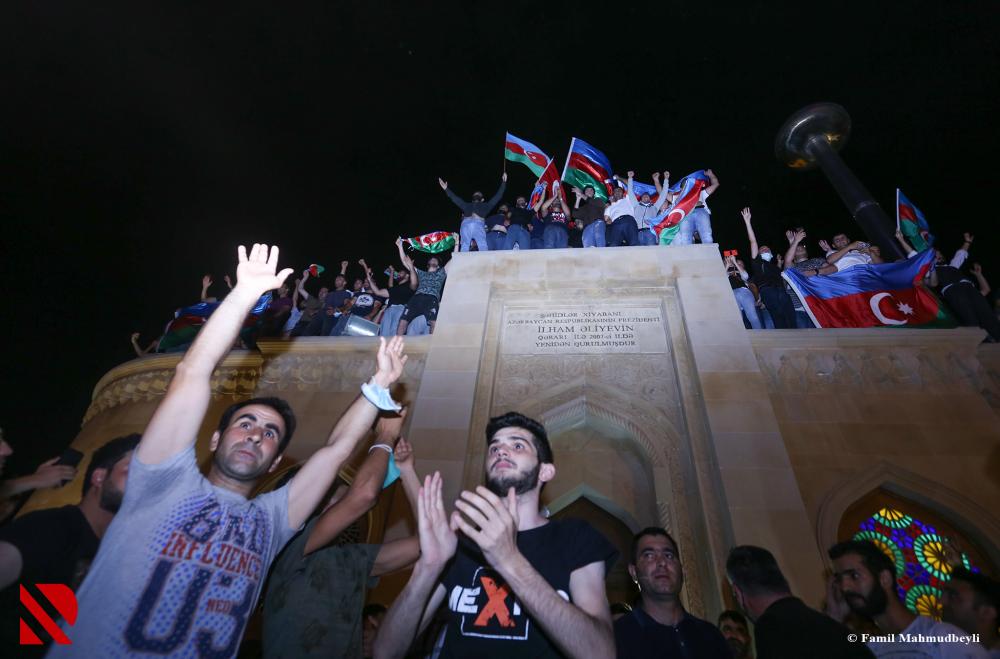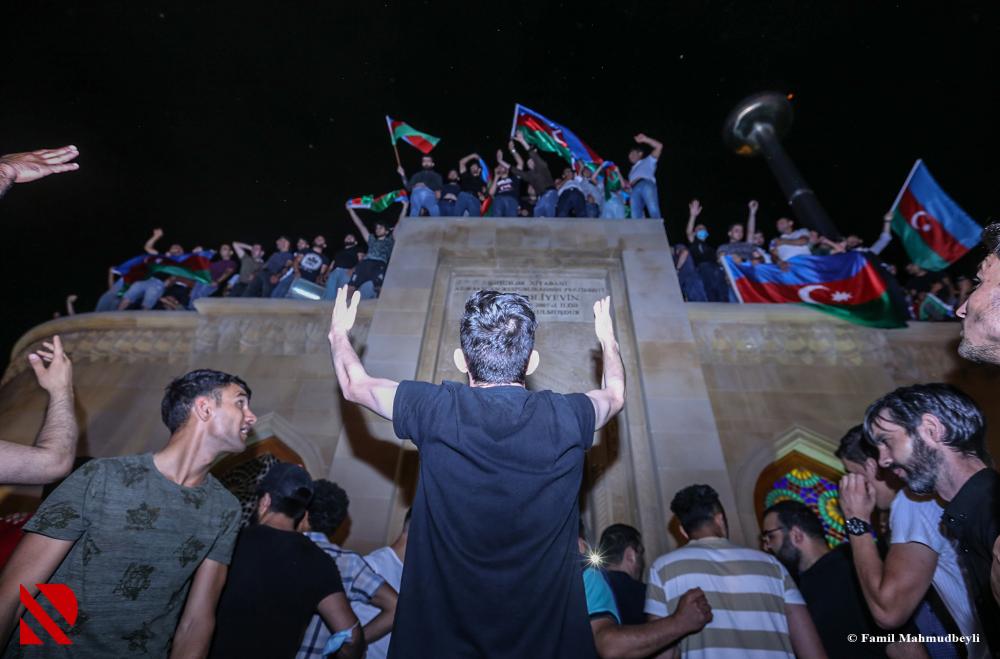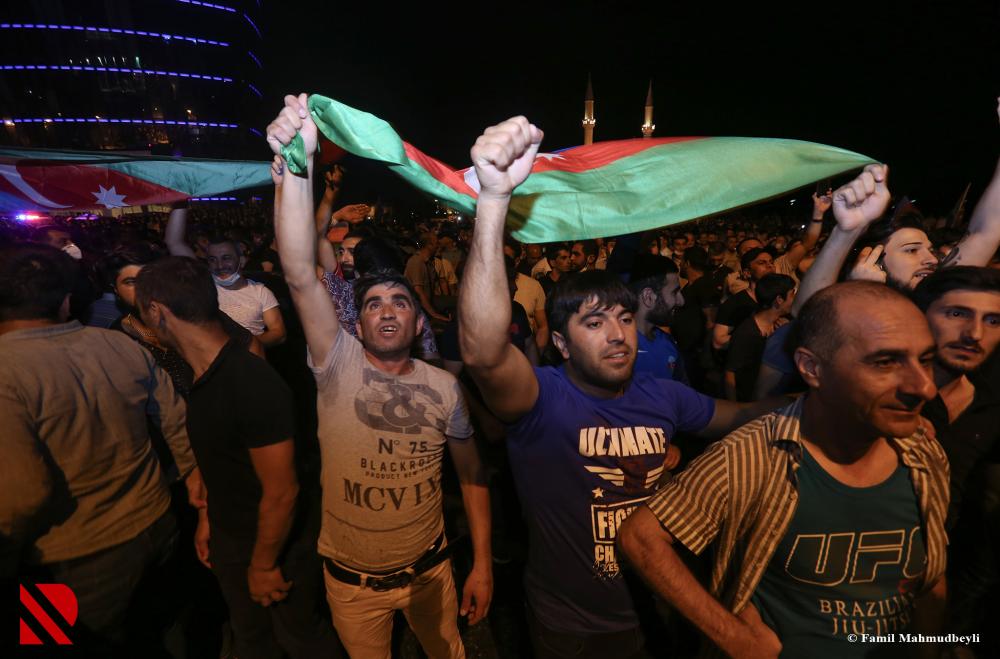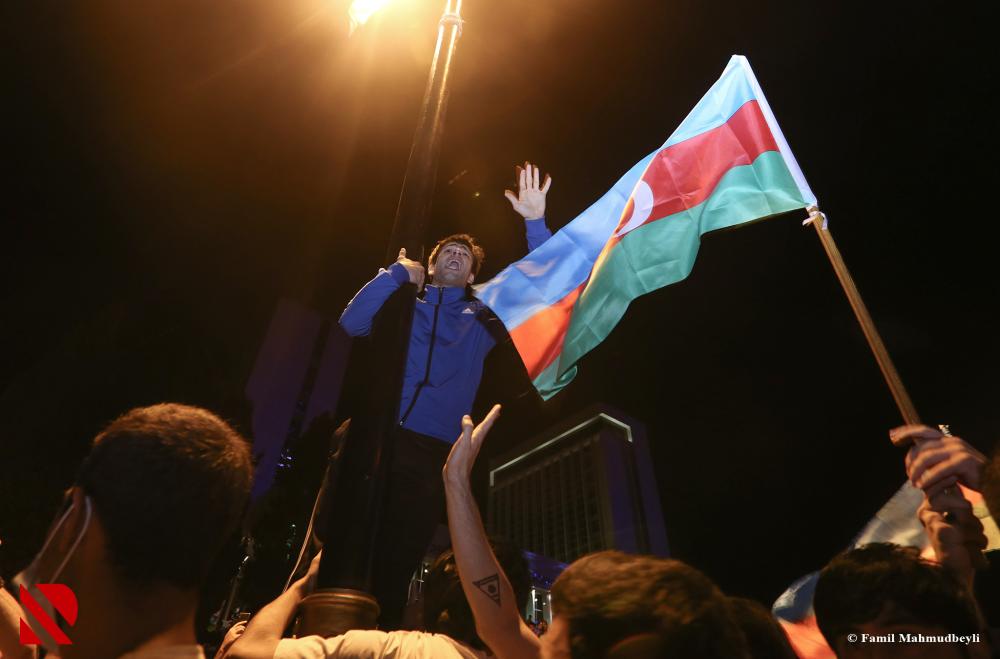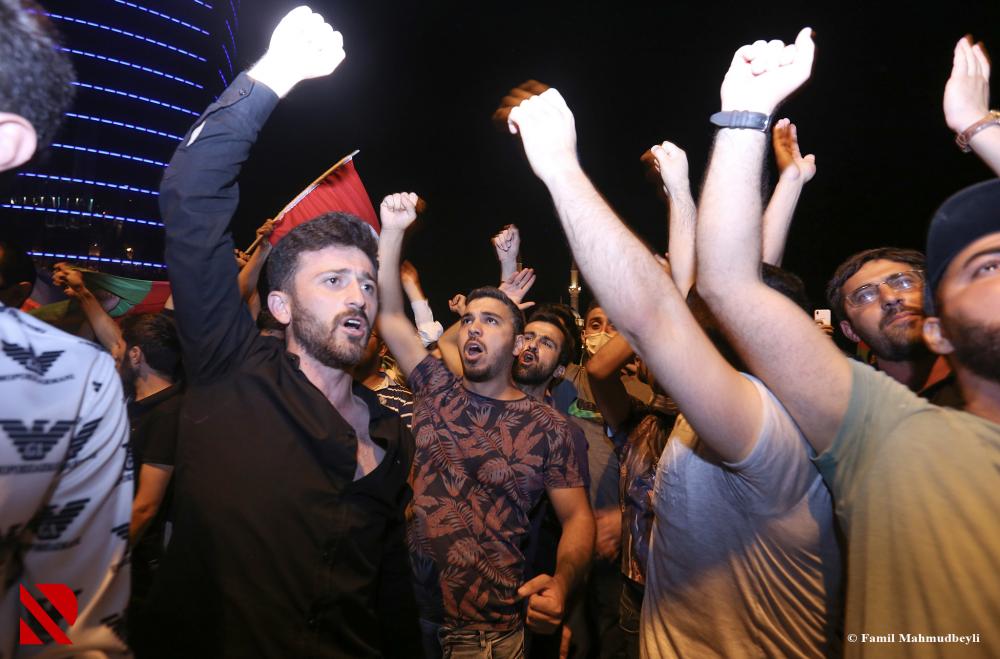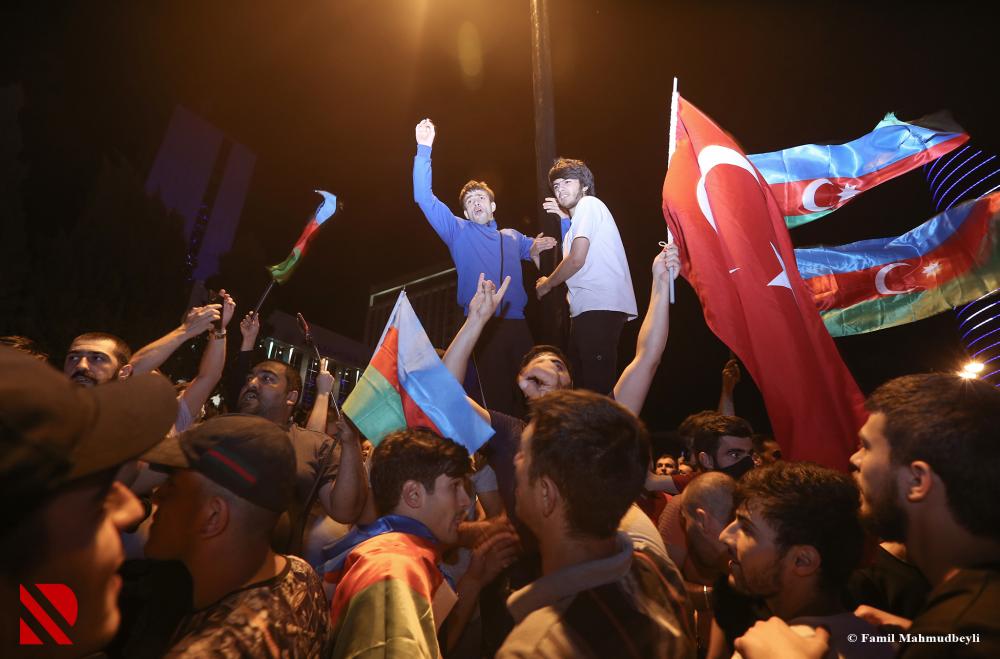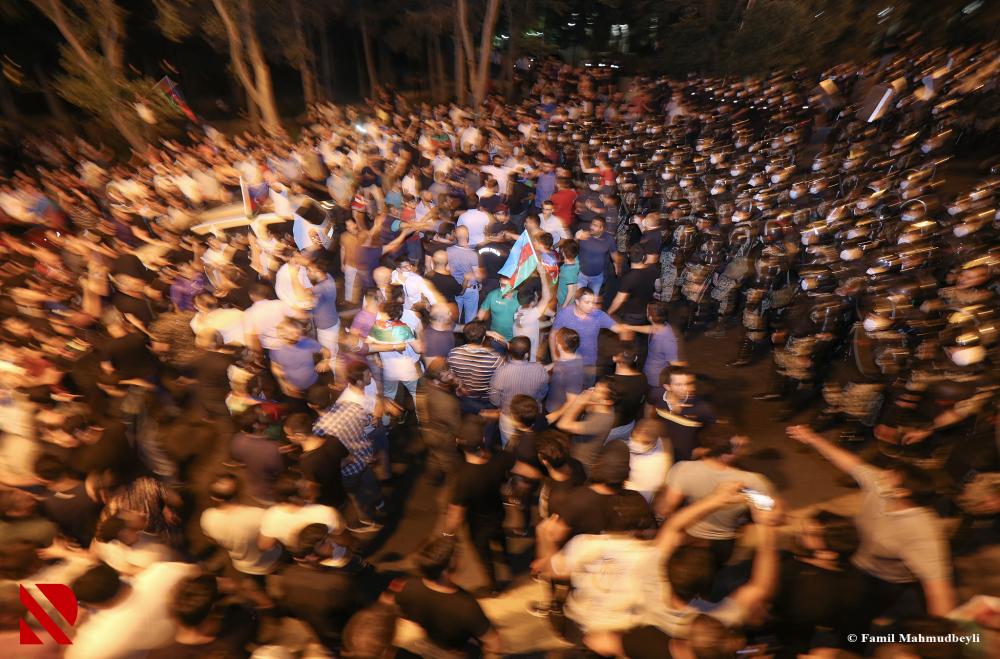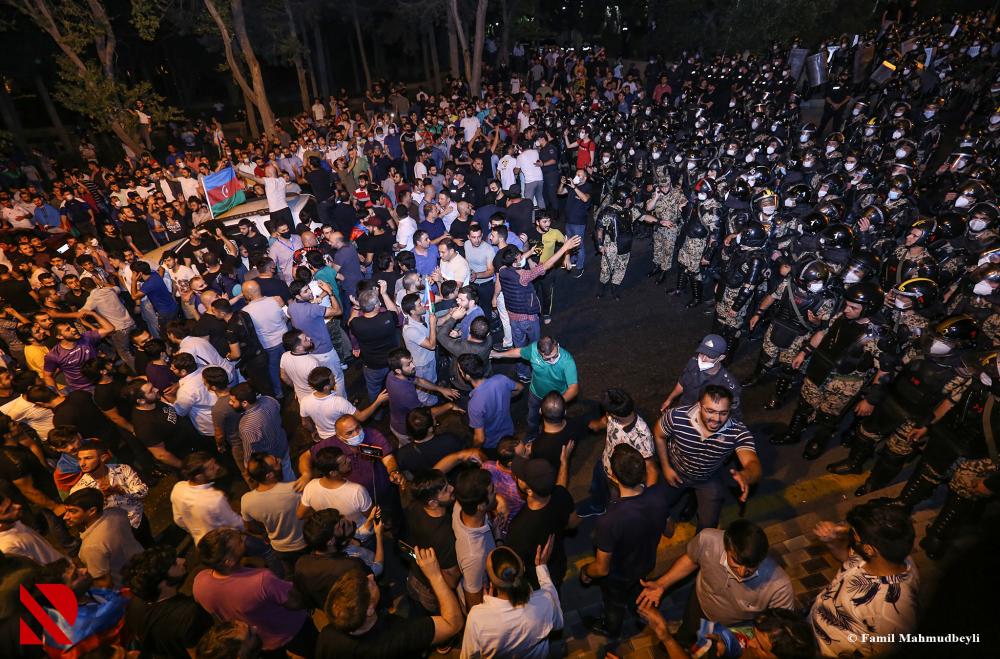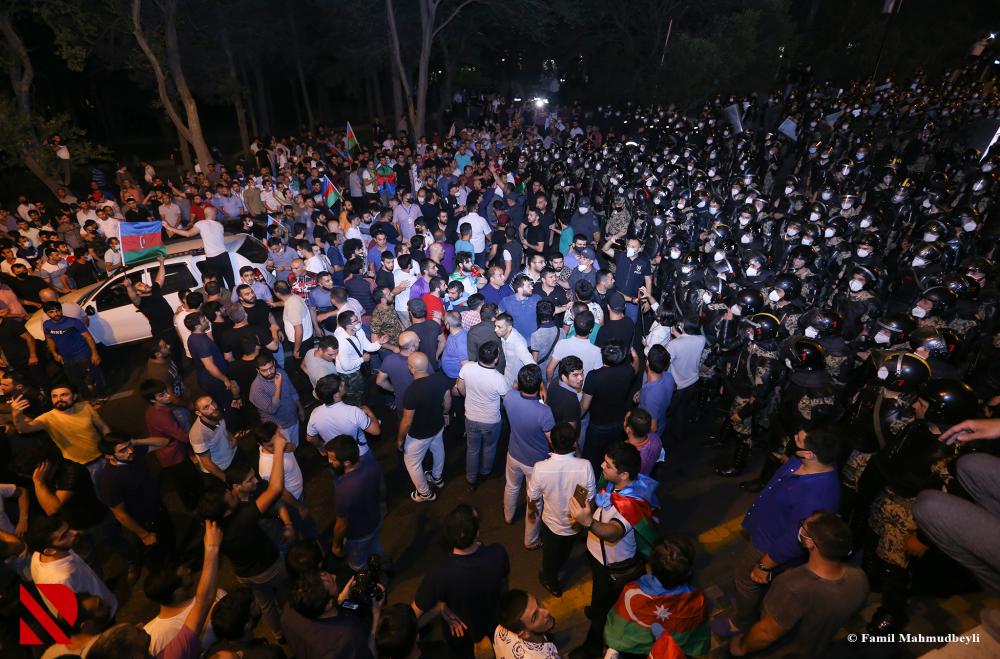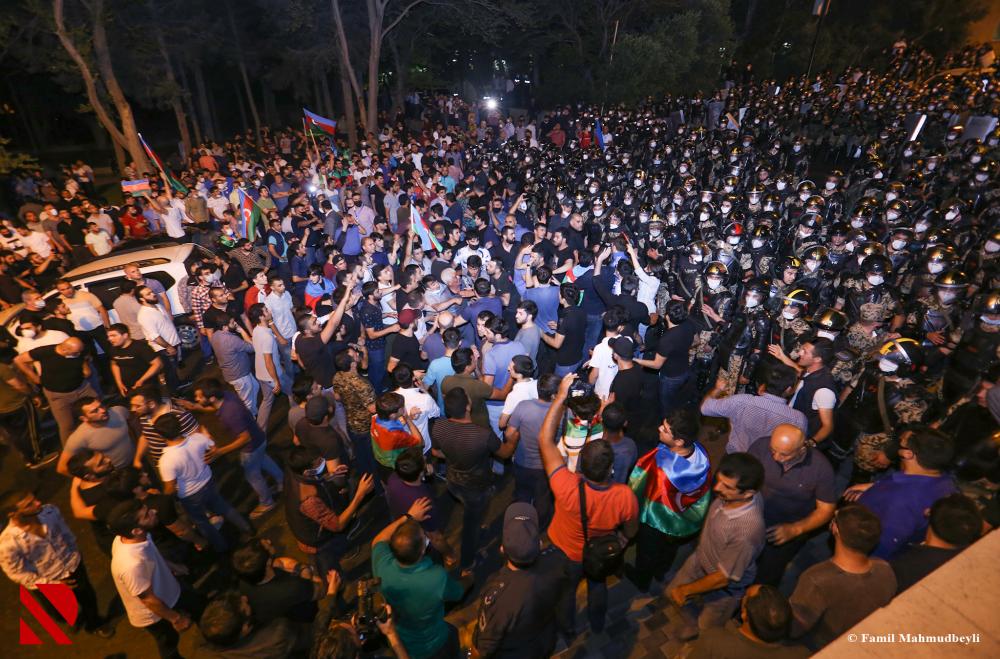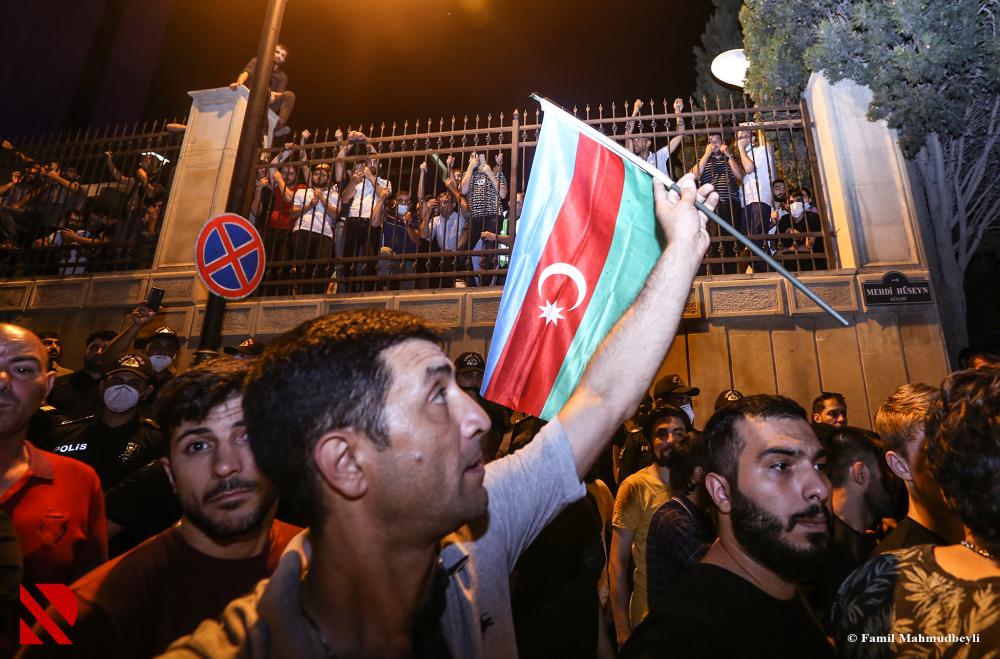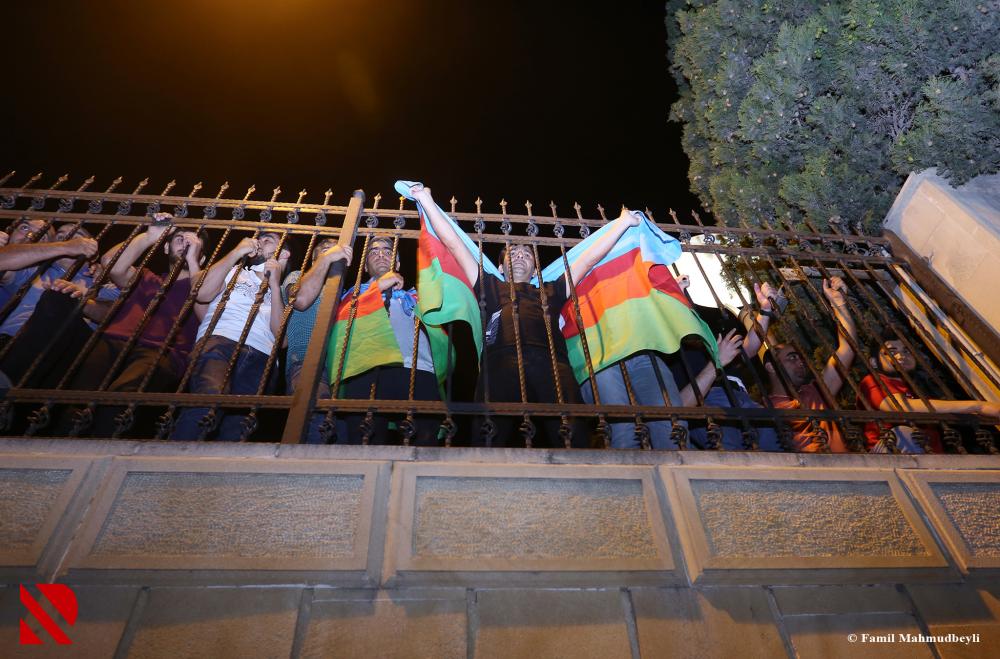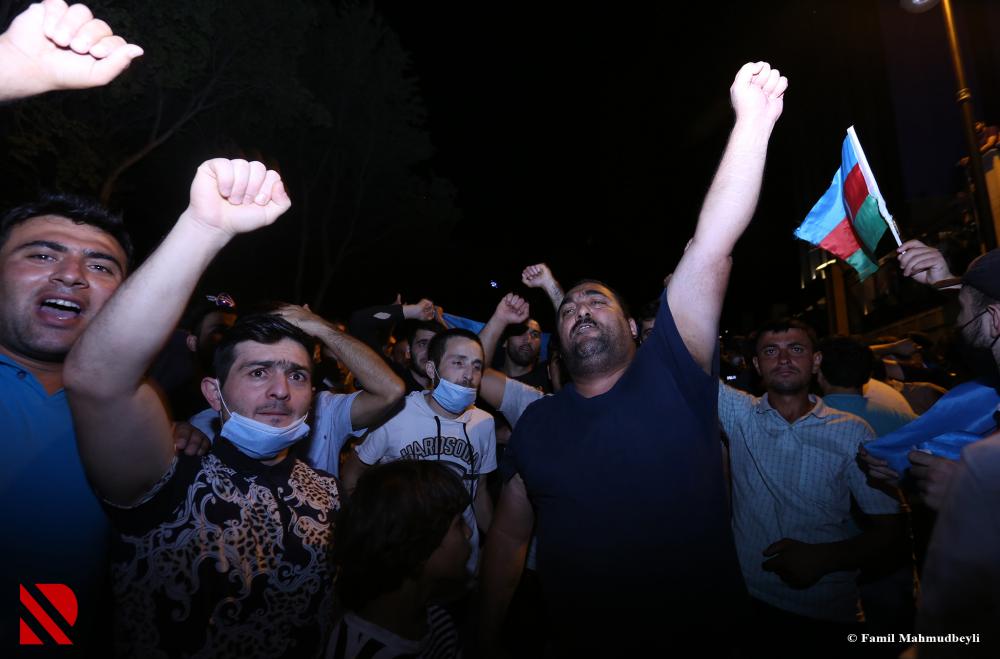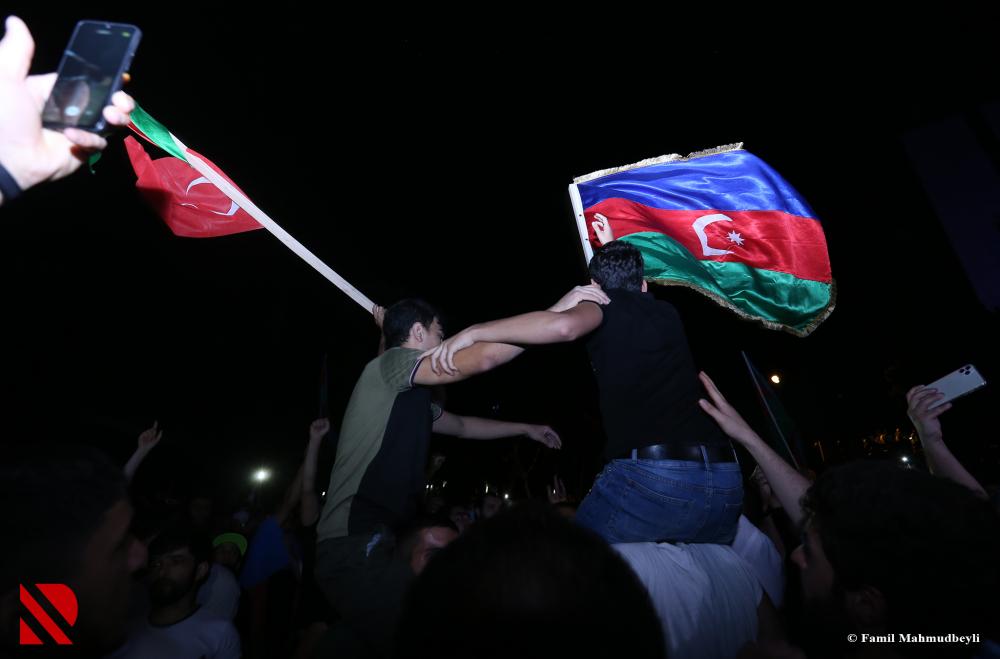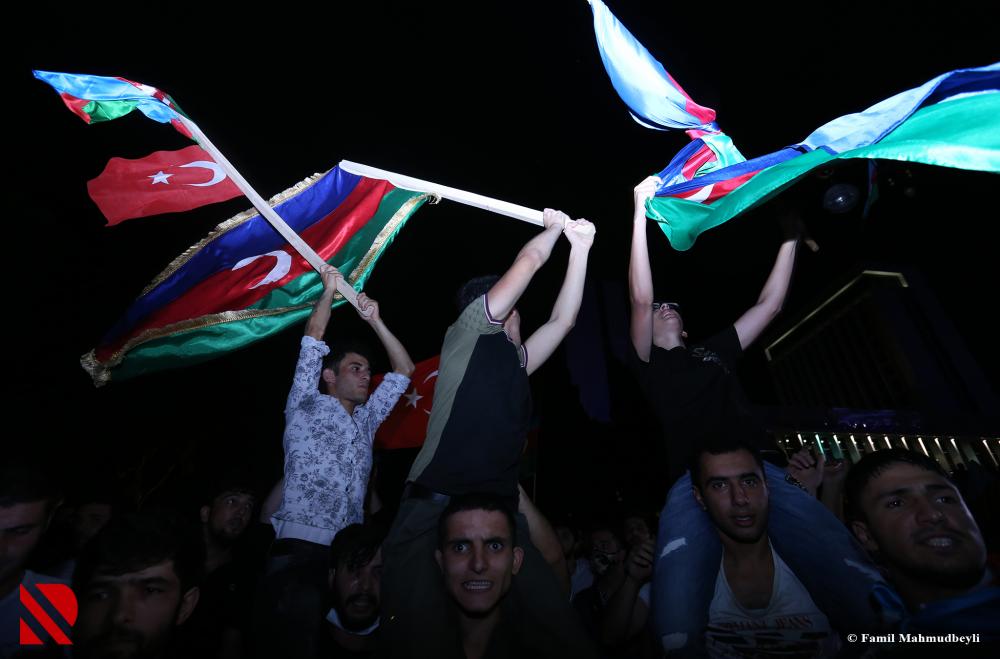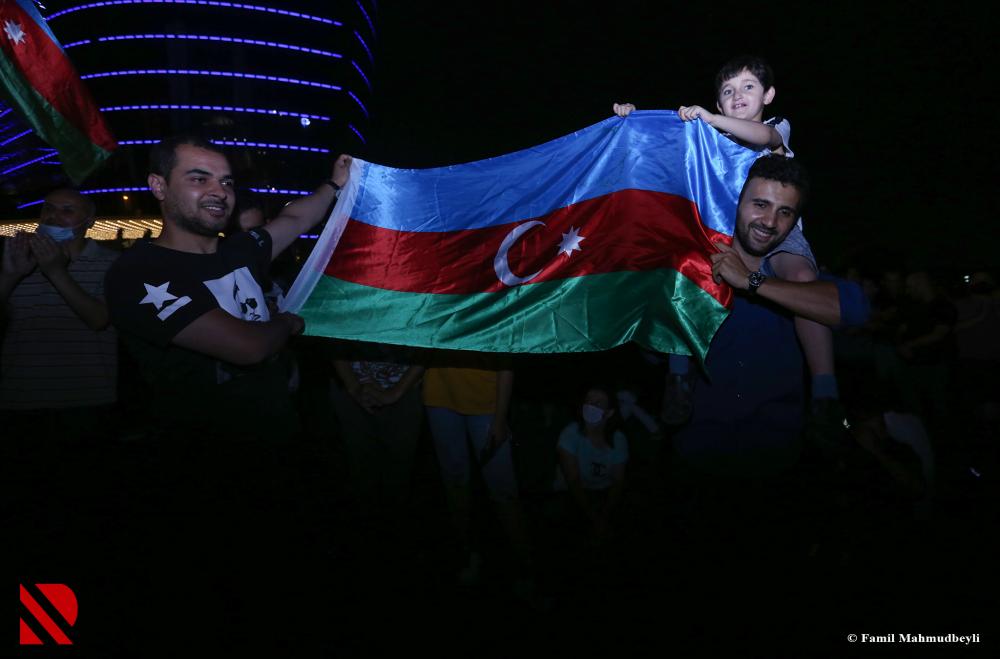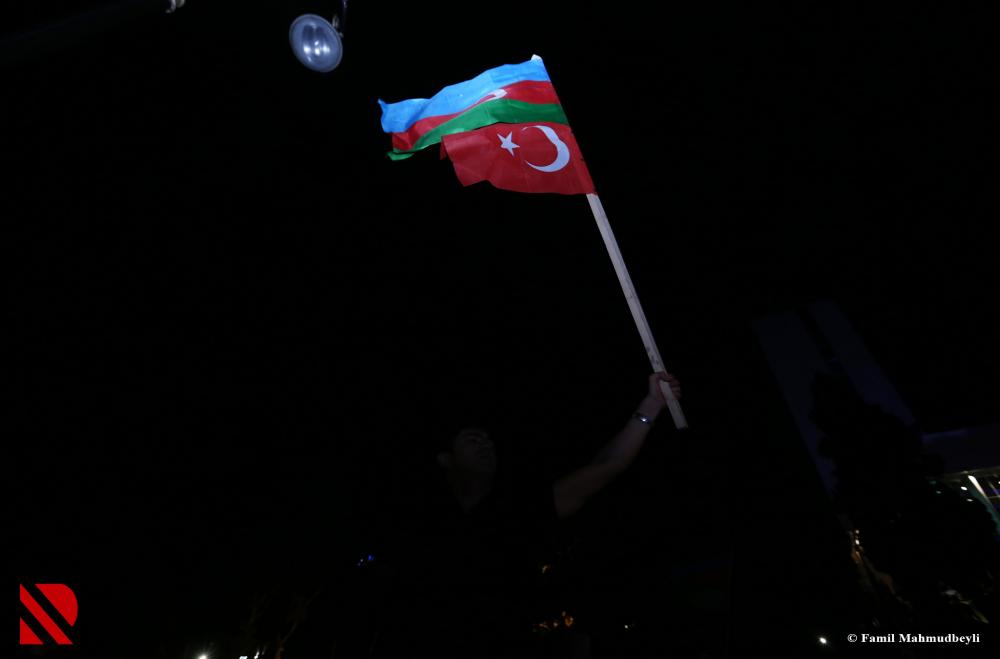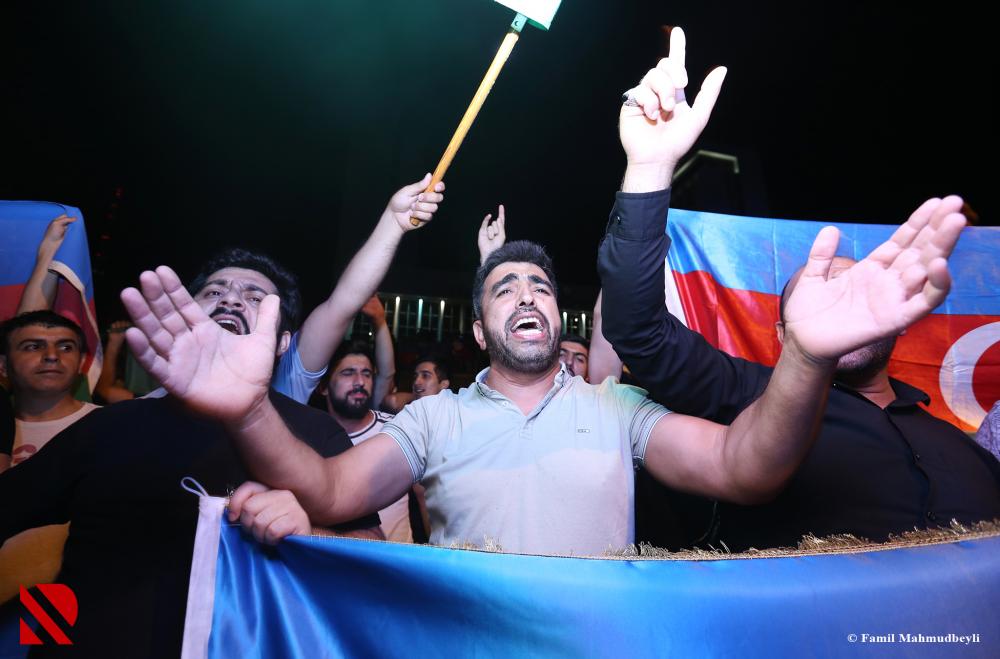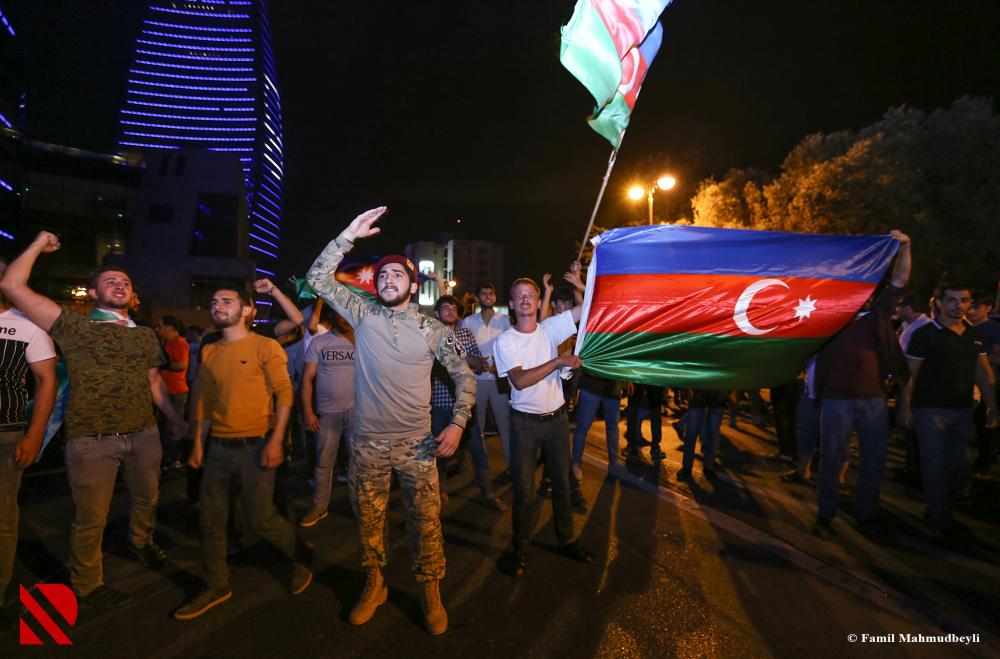On this historical day
Photos of the national rally of July 14 in the center of Baku in support of the national army
On the evening of July 14, 2020, the national rally began in Baku, the capital city of Azerbaijan. Several thousand people marched along the central streets of the capital, chanting patriotic slogans. Along the seaside boulevard, the participants of the rally walked to the upper part of the city. They waved national flags, chanting “Karabakh is Our,” “Glory to the army,” “Soldiers Ahead”, “Martyrs never die”.
A WAY TO 44 DAYS WAR
On September 27, 2020 the armed forces of Armenia, blatantly violating the ceasefire regime have launched another aggression against Azerbaijan, by intensively attacking the positions of the armed forces of Azerbaijan along the frontline, as well as by deliberately subjecting to artillery shelling residential areas of Tartar, Aghdam, Fuzuli and Jabrayil districts. On the following days, densely populated residential areas – Shamkir, Beylagan, Aghdam, Fuzuli, Jabrayil, Goranboy, Tartar, Barda, Aghjabadi and the city of Ganja were subjected to heavy bombardment, including with mid-range missiles.
The new aggression by Armenia against Azerbaijan was yet another blatant violation of fundamental norms and principles of international law, IHL, including the Geneva Conventions of 1949 and its Additional Protocols, as well as the United Nations Security Council resolutions 822, 853, 874, 884 of 1993 demanding the immediate, complete and unconditional withdrawal of the armed forces of Armenia from the occupied territories of Azerbaijan.
As a countermeasure of the Armenian aggression against Azerbaijan, on September 27, with the counter-offensive operation along the entire front Azerbaijani Army started the liberation of the territories, which had been occupied by Armenia in the wake of the First Karabakh War in the early 1990s. The war that lasted 44 days and labeled as ‘the Patriotic War’, depicted the strength of the Glorious Azerbaijani Army and ended with the decisive victory of Azerbaijan. By December 1, Azerbaijan has restored its territorial integrity at the result of the trilateral ceasefire treaty between Azerbaijan, Armenia, and Russia that signed on November 10, 2020, right after the liberation of the Shusha, the cultural capital of Azerbaijan, by the Glorious Azerbaijani Army. This 44 days war brought an end to the long-lasting occupation of the territories of Azerbaijan.
As a result of the 44 days war, totally 91 civilians, including children, women and elderly have been killed, more than 400 civilians have been wounded as a consequence of heavy artillery shelling and 2881 Azerbaijani soldiers were martyred more than thousand were wounded, while 28 are still missing.
WHY 44-DAY WAR HAPPENED?
The conflict between Azerbaijan and Armenia over the Nagorno-Karabakh region remains to be one of the most controversial issues of the modern history of the South Caucasus. Nagorno-Karabakh has been a historical territory of Azerbaijan and majority of population were ethnic Azerbaijanis for the past several centuries. Armenian population could prevail only during the last two centuries after the settlement of the Armenians in this region as a result of the treaties signed between Russian-Persian and Russian-Ottoman empires at the beginning of the nineteenth century.
Although the Versailles Peace Conference recognized Nagorno-Karabakh as part of the Azerbaijan Democratic Republic of 1918-1920, Armenia did not abandon its demand on the territory. After two years controversies between Azerbaijan and Armenia, when the South Caucasus countries became part of the Soviet Empire at the beginning of 1920s, Nagorno-Karabakh was again flagged as a topic of discussion. Therefore, while referring to pre-existing reality, plenum of Kavbureau CC RCP(b) (Caucasus Bureau of the Central Committee of the Russian Communist Party of the Bolsheviks) decided to leave Nagorno-Karabakh within the territory of Azerbaijan Soviet Socialist Republic according to the decree of the July 5, 1921. Further in 1923, it was granted with an autonomous status.
On the eve of the collapse of Soviet Union at the end of 1980s, the Regional Soviet of Nagorno-Karabakh decided to transfer the region to the sovereignty of Armenia, which was rejected not only by Azerbaijan SSR, but also by the Supreme Soviet of the USSR and the Central committee of the CPSU with reference to the Article 78 of the USSR Constitution. The Article 78 clearly signified that territorial alterations were unacceptable without the agreement of the affected union republic. Despite this fact, Armenians of Nagorno-Karabakh followed a secessionist policy and began to create their political structures with the direct support of the Armenian SSR.
Furthermore, Armenian side used the Soviet Law of 3 April 1990 “on the Procedures for Resolving Questions Related to the Secession of Union Republics from the USSR” as a legal basis to justify its separatist actions. These endeavors explicitly violated not only above-mentioned article of the Soviet Constitution, but also the 1990 April Law per se.
The termination of the USSR in 1991 was followed with several ethnic conflicts and war escalations within its former borderline. At the result, the Nagorno-Karabakh conflict, which has been one of the most controversial issues of the modern history of the South Caucasus that stemming from territorial claims of Armenia on historical Azerbaijani lands, broke out the hot war from 1991 to 1994. The war repercussion was daunting for Azerbaijan as the military operations were conducted with disproportionate capacities, and obvious support of the armed forces of the former USSR backed Armenians to violate Azerbaijani territorial integration by the occupation of 20% of its lands. Military aggressions did not only mean a territorial loss for Azerbaijan, but also devastated its cultural heritage, caused the refugee and IDP crisis, and traced a dreadful impact on the country’s economy.
After signing the ceasefire agreement between Azerbaijan and Armenia in May 1994, there were various peace proposals for the settlement of the dispute. Since the involvement of the Minsk Group in the negotiation process, the parties to the conflict held great hopes in this negotiating institute, as it consists of not only the regional countries, such as Russia and Turkey, but also European and North American countries, which inspired the belief that such a broad representation would end the conflict peacefully. However, Armenian side never put forward a constructive approach for the resolution of the conflict peacefully and consistently violated the ceasefire agreement of 1994 while targeting civilians along the borderlines.
Armenian ferocities and arbitrariness reached at its peak in last three years, which was significantly blocking peaceful settlement of the Nagorno-Karabakh conflict. Thus, the more aggressive and intractable action of the Armenian government, like an intention to cement the acquisitions of those occupied territories beyond Nagorno-Karabakh permanently, repudiation of the “Basic Principles” that had been initiated by the OSCE Minsk Group and accepted both parties to the conflict, planning to move the administrative center of the so-called Nagorno-Karabakh Republic from Khankendi to Shusha, the cultural capital of Azerbaijan, illegal settlement of Armenians from different part of the world in the internationally recognized territories of Azerbaijan, as well as changing the toponyms and falsification of the historical monuments triggered the tension between the sides.
In addition to all, at a rally in Khankendi on August 5, 2019, Armenian Prime Minister Nikol Pashinyan declared, “Artsakh is Armenia, and that’s it”. This destroyed the possibility of serious further negotiation. Furthermore, Armenian Defence Minister David Tonoyan said in New York in March 2020 that the policy “new war for new territories” replaced that of “territory for peace”, still further undermining any peaceful resolution.
However, the attack to Tovuz region in the summer of 2020 that is situated out of the conflicting zone and violating internationally recognized borders of Azerbaijan since that time became the last straw to break the status-quo in the region. Consequently, Azerbaijani servicemen and a civilian were killed as a result of artillery fire in the direction of Tovuz on the Armenian-Azerbaijani border. In regard with the situation that has developed in those days during the fighting in the direction of the Tovuz district of the Azerbaijan-Armenia state border, on the evening of July 14, 2020, the national rally began in Baku, the capital city of Azerbaijan. Several thousand people marched along the central streets of the capital, chanting patriotic slogans. Along the seaside boulevard, the protesters walked to the upper part of the city. The protesters waved national flags, chanting “Karabakh is Our,” “Glory to the army,” “Soldiers Ahead”, “Martyrs never die”.
Due to all these development, in his speech on July 15 the President of the Republic of Azerbaijan, the Supreme Commander-in-Chief of the Armed Forces, Mr. Ilham Aliyev noted that citizens who wish to enlist can submit their personal data to the State Service for Mobilization and Conscription. At the result, thousands of sons and daughters of Azerbaijan – patriots of their Homeland, our compatriots living abroad, servicemen in reserve, war invalids and veterans are applying to the Ministry of Defense with a request to call them up for military service and engage in military operations in order to support our Army. Therefore, from July 13-17 and later on, the Ministry of Defense received about thousands appeals on this issue.
In August, Armenia launched yet another military provocation. This time a sabotage group was sent to Azerbaijan. The head of the sabotage group was detained by the Azerbaijani military and is currently giving evidence. His statements clearly show that this sabotage group came to Azerbaijan with a plan to commit acts of terror. Targeting oil and gas export pipelines passing through Tovuz district was threatening European energy security. In this regard, a fragile ceasefire was established, although frequently broken in subsequent months by Armenia.
On September 27, 2020 the armed forces of Armenia, blatantly violating the ceasefire regime have launched another aggression against Azerbaijan, by intensively attacking the positions of the armed forces of Azerbaijan along the frontline, as well as by deliberately subjecting to artillery shelling residential areas of Tartar, Aghdam, Fuzuli and Jabrayil districts. On the following days, densely populated residential areas – Shamkir, Beylagan, Aghdam, Fuzuli, Jabrayil, Goranboy, Tartar, Barda, Aghjabadi and the city of Ganja were subjected to heavy bombardment, including with mid-range missiles. The new aggression by Armenia against Azerbaijan was yet another blatant violation of fundamental norms and principles of international law, IHL, including the Geneva Conventions of 1949 and its Additional Protocols, as well as the United Nations Security Council resolutions 822, 853, 874, 884 of 1993 demanding the immediate, complete and unconditional withdrawal of the armed forces of Armenia from the occupied territories of Azerbaijan.
That is why, as a countermeasure of the Armenian aggression against Azerbaijan, on September 27, with the counter-offensive operation along the entire front Azerbaijani Army started the liberation of the territories, which had been occupied by Armenia in the wake of the First Karabakh War in the early 1990s. The war that lasted 44 days and labeled as ‘the Patriotic War’, depicted the strength of the Glorious Azerbaijani Army and ended with the decisive victory of Azerbaijan. By December 1, Azerbaijan has restored its territorial integrity at the result of the trilateral ceasefire treaty between Azerbaijan, Armenia, and Russia that signed on November 10, 2020, right after the liberation of the Shusha, the cultural capital of Azerbaijan, by the Glorious Azerbaijani Army. This 44-day war brought an end to the long-lasting occupation of all occupied territories of Azerbaijan and restored its sovereignty over these territories.
Attacks on civilians
On September 27, 2020 the armed forces of Armenia, blatantly violating the ceasefire regime have launched another aggression against Azerbaijan, by intensively attacking the positions of the armed forces of Azerbaijan along the frontline, as well as by deliberately subjecting to artillery shelling residential areas of Tartar, Aghdam, Fuzuli and Jabrayil districts. On the following days, densely populated residential areas – Shamkir, Beylagan, Aghdam, Fuzuli, Jabrayil, Goranboy, Tartar, Barda, Aghjabadi and the city of Ganja were subjected to heavy bombardment, including with mid-range missiles.
As a result, there have been casualties among civilians and military servicemen of Azerbaijan. Extensive damage has been inflicted on many houses and other civilian infrastructure.
The new aggression by Armenia against Azerbaijan is yet another blatant violation of fundamental norms and principles of international law, IHL, including the Geneva Conventions of 1949 and its Additional Protocols, as well as the United Nations Security Council resolutions 822, 853, 874, 884 of 1993 demanding the immediate, complete and unconditional withdrawal of the armed forces of Armenia from the occupied territories of Azerbaijan.
According to preliminary estimation, as of October 30, totally 94 civilians, including children, women and elderly have been killed, more than 400 civilians have been wounded as a consequence of heavy artillery shelling. As of October 29, 2406 private houses, 92 apartment buildings and 423 civilian facilities were damaged and became unserviceable as a result of armed attack.
Martyrs
On September 27, 2020 the armed forces of Armenia, blatantly violating the ceasefire regime have launched another aggression against Azerbaijan, by intensively attacking the positions of the armed forces of Azerbaijan along the frontline, as well as by deliberately subjecting to artillery shelling residential areas of Tartar, Aghdam, Fuzuli and Jabrayil districts. On the following days, densely populated residential areas – Shamkir, Beylagan, Aghdam, Fuzuli, Jabrayil, Goranboy, Tartar, Barda, Aghjabadi and the city of Ganja were subjected to heavy bombardment, including with mid-range missiles.
The new aggression by Armenia against Azerbaijan was yet another blatant violation of fundamental norms and principles of international law, IHL, including the Geneva Conventions of 1949 and its Additional Protocols, as well as the United Nations Security Council resolutions 822, 853, 874, 884 of 1993 demanding the immediate, complete and unconditional withdrawal of the armed forces of Armenia from the occupied territories of Azerbaijan.
As a countermeasure of the Armenian aggression against Azerbaijan, on September 27, with the counter-offensive operation along the entire front Azerbaijani Army started the liberation of the territories, which had been occupied by Armenia in the wake of the First Karabakh War in the early 1990s. The war that lasted 44 days and labeled as ‘the Patriotic War’, depicted the strength of the Glorious Azerbaijani Army and ended with the decisive victory of Azerbaijan. By December 1, Azerbaijan has restored its territorial integrity at the result of the trilateral ceasefire treaty between Azerbaijan, Armenia, and Russia that signed on November 10, 2020, right after the liberation of the Shusha, the cultural capital of Azerbaijan, by the Glorious Azerbaijani Army. This 44-day war brought an end to the long-lasting occupation of the territories of Azerbaijan.
As a result of the 44-day war, totally 94 civilians, including children, women and elderly have been killed, more than 400 civilians have been wounded as a consequence of heavy artillery shelling and 2908 Azerbaijani soldiers were martyred, more than thousand were wounded, while 6 are still missing.
